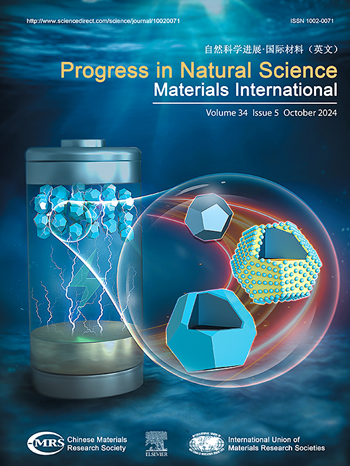一种火焰合成法制备富镍NCM正极材料的氧化物前驱体路线
IF 7.1
2区 材料科学
Q2 MATERIALS SCIENCE, MULTIDISCIPLINARY
Progress in Natural Science: Materials International
Pub Date : 2025-06-01
DOI:10.1016/j.pnsc.2025.04.001
引用次数: 0
摘要
在目前的共沉淀法湿化学中,首先制备Ni-Co-Mn氢氧化物前驱体,在煅烧过程中进行高温分解,形成相应的Ni-Co-Mn氧化物与锂盐混合,最终合成正极材料LiNixCoyMn1-x-yO2 (NCM)。上述制备NCM正极材料的氢氧前驱体路线通常会导致多单元操作、大量的液体浪费、强碱污染和高资源消耗。本研究旨在通过火焰合成(FS)方法提出一种替代氧化前驱体制备NCM正极材料的方法,以缓解通常湿化学方法的上述问题。具体而言,基于共流扩散火焰燃烧器,采用FS法制备了Ni-Co-Mn氧化物,合成的氧化物前驱体未经任何处理,与碳酸锂(Li2CO3)混合煅烧,成功制备了富镍NCM811正极材料。结果表明:NCM811的氧化物前驱体Ni0.8Co0.1Mn0.1O1.1由初生NiO岩盐相和次生尖晶石结构相组成,与NiCo2O4和NiMn2O4相似,表面粗糙,结构呈球形,粒径约为1.2 μm,元素分布均匀;所制备的NCM811正极材料的初始放电比容量高达194.7 mAh/g, 100次循环后的容量保持率为87.1%,优于市面上的样品或文献报道的其他方法制备的材料。综上所述,Ni-Co-Mn氧化物前驱体途径是制备富镍NCM正极材料的重要途径。本文章由计算机程序翻译,如有差异,请以英文原文为准。

An oxide precursor route for manufacturing nickel-rich NCM cathode materials through the flame synthesis approach
During the current co-precipitation wet chemistry methods, the Ni-Co-Mn hydroxide precursor is initially prepared, which undergo high-temperature decomposition in calcination process, forming the corresponding Ni-Co-Mn oxides to mix with lithium salts, eventually leading to the synthesis of cathode materials, LiNixCoyMn1-x-yO2 (NCM). The above hydroxide precursor route for the preparation of NCM cathode materials usually result in multiple unit operations, substantial liquid wastes, strong base contamination, and high resources consumption. The present study aims at proposing an alternative oxide precursor route for manufacturing NCM cathode materials through the flame synthesis (FS) approach, to alleviate the above issues of the usual wet chemistry methods. Specifically, based on a co-flow diffusion flame burner, the Ni-Co-Mn oxides was prepared by FS, and the as-synthesized oxide precursor, without any treatment, was then mixed with lithium carbonate (Li2CO3) to undergo calcination, leading to the successful preparation of the nickel-rich NCM811 cathode materials. Results show that the oxide precursor of NCM811, Ni0.8Co0.1Mn0.1O1.1, is composed of a primary NiO rock salt phase and secondary spinel-structured phases similar to NiCo2O4 and NiMn2O4, with rough surface, spherical structure, particle size of about 1.2 μm, and uniform distribution of the elements. The initial discharge specific capacity of the resulting NCM811 cathode materials achieve as high as 194.7 mAh/g, with capacity retention being 87.1 % after 100 cycles, which is superior to that of commercial samples or prepared by other methods as reported in literatures. Overall, the Ni-Co-Mn oxides precursor route through FS is compelling to the preparation of nickel-rich NCM cathode materials.
求助全文
通过发布文献求助,成功后即可免费获取论文全文。
去求助
来源期刊
CiteScore
8.60
自引率
2.10%
发文量
2812
审稿时长
49 days
期刊介绍:
Progress in Natural Science: Materials International provides scientists and engineers throughout the world with a central vehicle for the exchange and dissemination of basic theoretical studies and applied research of advanced materials. The emphasis is placed on original research, both analytical and experimental, which is of permanent interest to engineers and scientists, covering all aspects of new materials and technologies, such as, energy and environmental materials; advanced structural materials; advanced transportation materials, functional and electronic materials; nano-scale and amorphous materials; health and biological materials; materials modeling and simulation; materials characterization; and so on. The latest research achievements and innovative papers in basic theoretical studies and applied research of material science will be carefully selected and promptly reported. Thus, the aim of this Journal is to serve the global materials science and technology community with the latest research findings.
As a service to readers, an international bibliography of recent publications in advanced materials is published bimonthly.

 求助内容:
求助内容: 应助结果提醒方式:
应助结果提醒方式:


